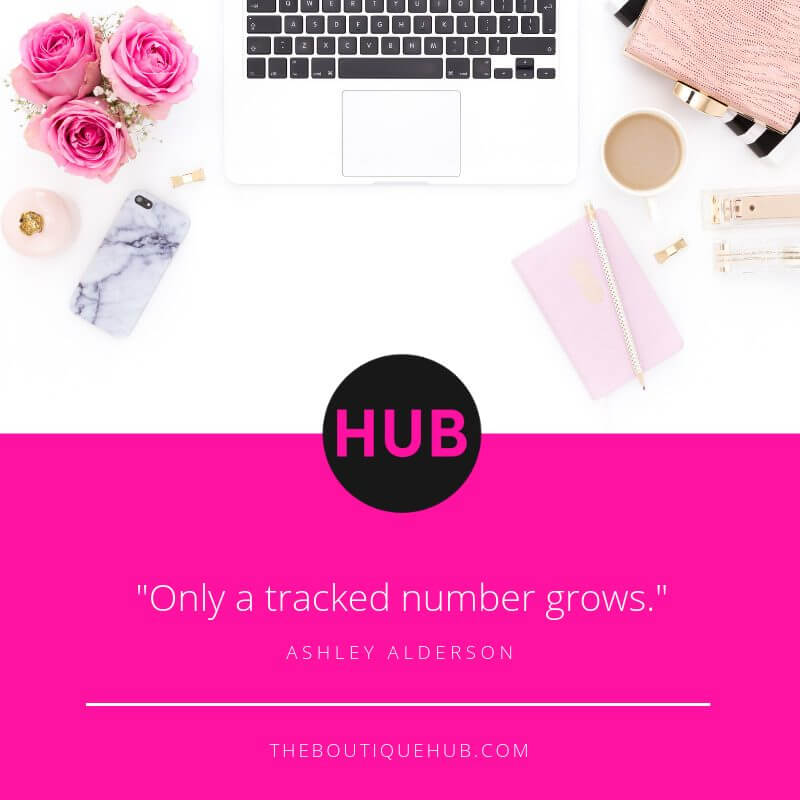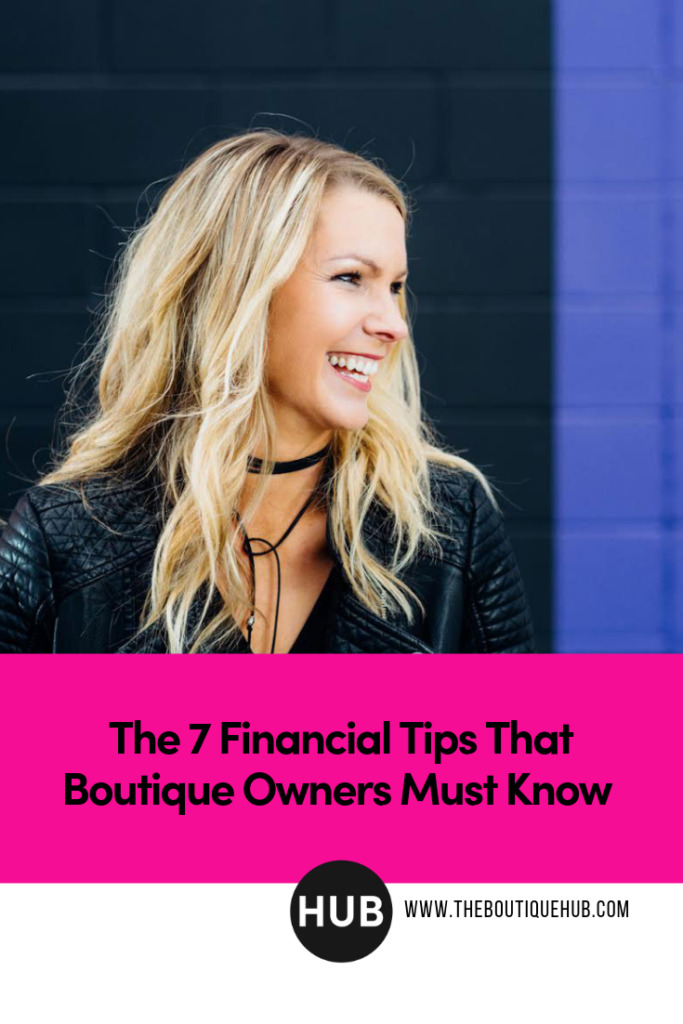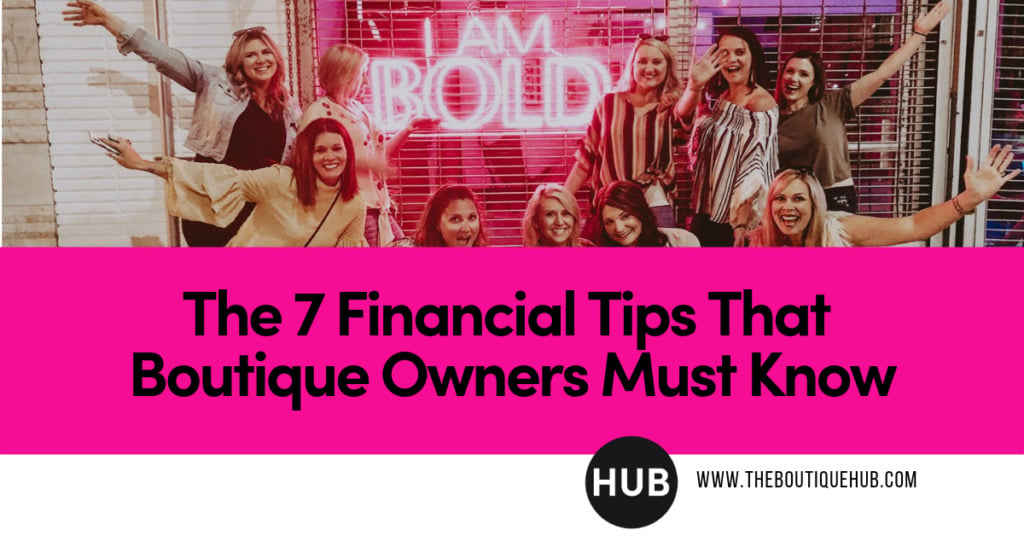Today we are talking about the 7 must-know financial tips for boutique owners. These critical financial skills are the key to longevity and growth in business.
Only a tracked number grows.

To be a successful boutique owner, it not only takes great taste and style but really a four legged stool of skills. Owners need to have smart marketing strategy, people skills, a great eye for style and buying, and most importantly we could argue, a firm knowledge of the numbers that make your business tick. Without which, you can’t buy, your marketing will break you and your people skills won’t see the light of day.
Convinced?
Working with thousands of boutique owners on a daily basis at The Boutique Hub, we uncover a number of skills that become overlooked and wanted to get your feet wet on the topics most crucial. These are the basic skills you must have and deeply understand to grow a flourishing business.
7 Financial Tips for Boutique Owners

1. Get Organized.
This first financial tip is simple but crucial. Most boutique owners start boutiques because they are creative and love to shop. So if the analytical side of your brain doesn’t work, you’ll find a program to help you. Getting organized is more than throwing receipts in a box, it’s setting time in your schedule on a weekly basis to track, read and understand your numbers so you can make wise business decisions and inventory buys as you go.
Quickbooks is the most essential tool to get organized. Starting at just $20 a month for the online version, Quickbooks can plug into your Shopify site, PayPal, and Bank Account to make tracking income and expenses as simple as a few clicks of a button. Then, when it’s time, your accountant has a simple, ready to print report to help you file your taxes and work on your payroll.
2. Start Tracking and Organizing Your Sales by Class and Category.
A sale is not a sale. Each sale you make is your customers ‘voting’ on what they like and don’t like. Then, at the end of the day, your ‘winners’ are the products that sell the fastest and make you the most money.
So why not start breaking down your product categories further to understand the data that drives products? More than tops, bottoms and dresses, it’s time to understand your product turn on a deeper level. We’ll use graphic tee’s, fashion tops, basics, outerwear, dresses & kimonos, jeans and bottoms as a place to start. Notice how we aren’t lumping such diverse products together any longer? Now we can use our sales to help us make smarter inventory purchases.
Tracking inventory by class and breaking down costs can all be done in your Point of Sale system, or working with a merchandised planner. We have a great partnership with Management One (Merchandised Planners) and soon, a number of POS companies who we are working to pre-qualify for the needs we see the most in our boutique community.
For more in-depth on this financial topic, check out this recent #BoutiqueChat on YouTube.
3. Know your cost, your margins and how to set your price.
If you’re not marking your items up at least 2.5 to 3 times at minimum, you don’t have a business, you have a hobby. That business model will never survive because you cannot pay yourself, pay employees when you grow, or make investments in your business or future.
Price is a number that we set based on our needed markup or margin to cover our costs, operating expenses and profit. We reach that price not by math alone, but also by asking ourselves – how much do I think this product will bring? Or, how much do others sell this item for? Many times our markup exceeds 3x based on a good buy that we scouted or knowing it’s demand and value in the market.
Remember, price is also the point at which our perceived value of an item exceeds its perceived pain of cost. So the most we up level the perception of our brand, educate our customers on an item’s quality or value, or show how many ways this item can be worn or styled, the more that item is worth. The boutique owner’s job is to communicate this.
4. There are only 3 ways to grow your business.
- Get new customers.
- Sell more to existing customers.
- Grow your margin.
It’s time to be smarter about who we are targeting and why. Sure, it’s great to be constantly growing your followers or new customers, but statistics show that 80 percent of our revenue often comes from 20 percent of our list. Are you treating your existing customers well and re-marketing to them?
This is where an old fashioned phone call, a text message, a segmented email list of a VIP night for your best customers becomes not only more money in your pocket and happier customers but also word of mouth that money can not buy.
This is also your opportunity to cross-sell and upsell. Cross-selling is providing your customer with another product that compliments or pairs well with the one she is already purchasing. Up Selling is adding on a sale to your existing sale — think add-on items at your counter or special offers that can help increase your AOV – Average Order Value.
Nurture your customers and they will, in turn, grow your business with a few super fans rather than a thousand cold followers.
5. Blanket Sales are Stupid.
If there was one financial tip that I hope you take my adice on it’s this one. Stop it. Stop discounting yourself so much that your business that started with a great margin is now back down to a hobby. Discount shoppers aren’t loyal, and blanket sales only attract customers looking for such. Not ones that want style, trust or relationships. Start marking down your products with a strategy. Use slow-turning items as your loss leader to bring faces into the store (or website), and while they gobble up a great deal, they also find add-on items that they didn’t know you had.
Build excitement with specific categories that need to turn due to a season change, a new shipment you are expecting, or because they have been on the floor too long, but don’t give away the highest demand, fastest turning, best sellers in your window.
6. Aging Inventory Holds Cash Hostage.
When you understand your categories and classes on a deeper level, and use a quality Point of Sale system, you can see your aged inventory. Building a profitable business means turning your products at a faster rate, so when your cash is tied up in a dud that won’t move, it’s held hostage from allowing you to grow.
Rather than starting with a discount to move the slow products, consider your presentation first. Restyle the products on a new model, in a new flat lay, with a new outfit, or re-merchandise them in your store. Make the item appear new and re-share it as a new arrival. Sometimes a new take on an old design makes all of the difference.
Only after you’ve done your best to push a full margin out of your product, then you begin your discount process. The faster, the better to get that cash back to help you reinvest.
7. Expenses vs Investments.

Expenses are costs that are static, you budget for them to operate your business. You budget and plan for them, including your payroll. However, there are some categories within your expenses that can also be looked at as investments. Facebook Ads, when understood, studied and proven to built an ROI (return on investment)you’re your marketing are an investment. So often when working with boutique owners on how to use Facebook Ads with success, we see them limiting their budget, and therefore their effectiveness. Now, this does not mean you should go wildly blow $500 on ads, but this does mean you need to find an expert TEACHER to show you how to set up your ads effectively, test out your audiences and messages to build a return, then like a faucet, turn those ads up. At that point, the more you spend, the more you will make.
Finding a great coach is the same or business expert is the same concept. In today’s age, every piece of information you need to succeed is online. And you could spend years searching for it all, and still not have the level of success you desire. When you invest in yourself whether it’s through a membership program like The Boutique Hub, or with an online training or one on one coach, you shave off years of research, thousands of dollars in mistakes, and can rest easier knowing that someone has your back and understands exactly where you are in business right now. This is an investment that both saves and makes you money for the long-term, making it’s investment ‘price’ one to be considered in a new light.
How are you investing in your business right now? What financial decisions are you making that are propelling you forward or holding you back?
Let us know in the comments, we’d love to hear your take on these 7 financial tips!
Like this blog post? Our 7 Financial Tips is our #1 Watched Video! Watch the live video here on our YouTube Channel with Ashley.
Want more financial tips and strategy for your boutique, brand and the industry as a whole? Make sure you are on our email list, or join us for the most in-depth resources, training library, company profiles and collaborations at www.theboutiquehub.com/join.

